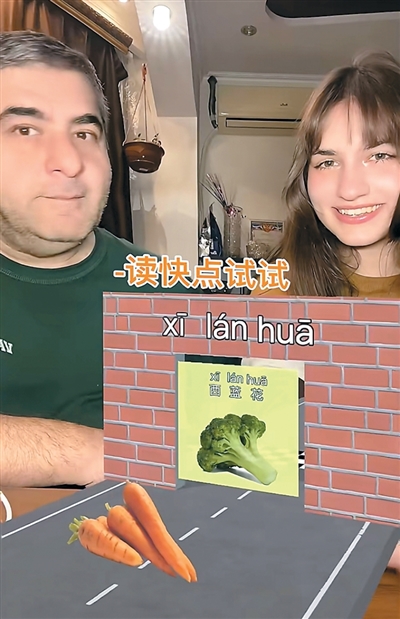Isabella, a Russian college student majoring in Chinese, posted a “Chinese Challenge” video on social media in February. She invited her father, who speaks basic Chinese, to join the game, correcting his pronunciation of Chinese words. The video racked up nearly 5 million likes and 4 million shares on Douyin (China’s TikTok).

Have you ever come across a “Chinese Challenge” video by a foreigner? These short clips involve reading Chinese words correctly using pinyin prompts and image clues, turning it into a fun word game. Lately, this game, dubbed the “Chinese Challenge” by foreign netizens, has captured the attention of more and more people overseas.
As these challenges go viral, they’re not just a social media trend—they signal a new way for Chinese to spread globally. The Chinese Challenge’s breakout success comes from its entertaining format and its ability to ride the wave of social media’s reach.
First, the gamified learning experience transforms the “world’s hardest language” into a fun, interactive activity, making Chinese characters feel more approachable for foreigners.
Traditionally, learning Chinese meant setting aside dedicated time with physical textbooks or online classes, sitting attentively through lessons. The complexities of pinyin tones, character strokes, and grammar often scared people off. But the Chinese Challenge flips this model. With just a smartphone, anyone can film a short video practicing Chinese pronunciation, feeling the thrill of progress and the joy of nailing a challenge. When characters and their sounds become playful game props instead of facts to memorize, reading skills improve almost effortlessly.
Second, social media’s collaborative and interactive nature has fueled the popularity of this “learn-through-play” approach.
Data shows over 5 billion users are active on short-video platforms daily. Algorithms on apps like TikTok ensure Chinese Challenge videos reach users interested in Chinese culture. One foreign vlogger captioned their video: “We’re trying to learn Chinese and having a blast, but clearly, we need more practice (lol). Drop some tips in the comments!” Many of these videos spread exponentially, earning millions of likes and shares, sparking discussions, and inspiring others to join the challenge.
What’s more, these challenges cover not only basic words like vegetables and animals but also trendy Chinese internet slang, like “waiting for the follow-up” or “you’re actually kinda nice.” This helps foreigners learn the latest, most authentic everyday expressions. The rapid growth of social media in the internet age has created a vital new channel for spreading Chinese, bridging the gap between textbook phrases and real-world spoken language.

In the future, short-video platforms and video apps could create more interactive Chinese-learning tools. For example, when a user makes a “six” hand gesture, the screen could display the Chinese phrase “liù liù dà shùn” (smooth sailing) with foreign-language explanations, helping users grasp the cultural significance of numbers in Chinese.
From brush calligraphy to keyboard typing, from classrooms to daily life, from paper textbooks to digital games, the ways Chinese is shared are evolving. Yet the trend remains clear: making it approachable. In the future, as more foreigners use Chinese-themed effects to document their lives, we’ll see that bridges of cross-cultural friendship are built in these fun, everyday interactions.










